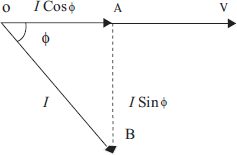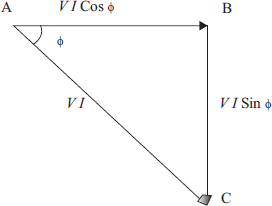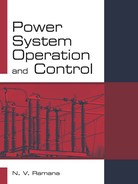8.2 POWER FACTOR
The cosine of the phase angle between two electrical quantities such as voltage and current in an AC circuit is known as power factor.
For instance, consider a load supplied by a voltage V and drawing a current of magnitude I, which lags the voltage by an angle ϕ. The phasor diagram of the circuit is given, in Fig. 8.1. The power factor of the circuit is given by,
Power Factor = Cos(ϕ)
The load current I can be resolved into two components.
- Horizontal component, I Cos ϕ in phase with the applied voltage V
- Vertical component, I Sin ϕ, 90° out of phase with the applied voltage V
The horizontal component, I Cos ϕ is known as active or wattful component and the vertical component, I Sin ϕ is known as the reactive or wattless component. The reactive component is a measure of the power factor. Greater the reactive component, larger the phase angle (ϕ) between the applied voltage and the current drawn by the load. Hence the power factor Cos ϕ is low. Therefore, a circuit having small reactive current I Sin ϕ will have high power factor and vice-versa.

Fig 8.1 Phase diagram, I lags V
Power factor is a characteristic of alternating current (AC) circuits. Its value is always between (0.0) and (1.0), the higher the number, the greater or better the power factor. If a purely resistive load is connected to a power supply, the current and voltage will be in phase with each other, and the angle ϕ equals to zero. Consequently, the power factor will be unity and the electrical energy flows in a single direction across the network in each cycle.
Inductive loads such as transformers and motors (any type of wound coil) generate reactive power with current waveform lagging the voltage. Capacitive loads such as capacitor banks or buried cables generate reactive power with current phase leading the voltage. Both types of loads will absorb energy during part of the AC cycle, and store it in the device’s magnetic or electric field, only to return this energy back to the source during the rest of the cycle.
The power factor concept can also be analyzed in terms of power drawn by the circuit, from the power triangle shown in Fig. 8.2

Fig 8.2 Power triangle
The right angled triangle ABC shown in Fig. 8.2 is known as the power triangle and is directly drawn from the triangle OAB in the phasor diagram shown in Fig. 8.1 Each side of the current triangle OAB of Fig. 8.1 is multiplied by voltage V, to get the power triangle ABC shown in Fig. 8.2.
To understand the power factor, we will first start with the definition of some basic terms: From the power triangle ABC,
AB = V I Cos ϕ, which represents Active Power (also called Actual Power or Working Power or Real Power) and is measured in Watts or Kilowatts i.e., W or KW. It is the power that actually enables the equipment and performs useful work.
BC = V I Sin ϕ, which represents Reactive Power and is measured in Volt Ampere Reactive i.e., VAR’s or KVAR’s. It is the power that a magnetic equipment (transformer, motor etc.,) needs to produce the magnetizing flux.
AC = V I, which represents Apparent Power and is measured in Volt Amperes or Kilo Volt Amperes i.e., VA’s or KVA’s. It is the “vectorial summation” of KVAR and KW.
The power factor can also be defined in terms of power by inferring some points from the power triangle.
The apparent power V I has two components. One is V I Cos ϕ i.e., Active Power and the other one is V I Sin ϕ i.e., Reactive Power at right angles to each other.
From the power triangle which is a right angled one, we can write,
AC2 = AB2 + BC2
(Apparent power)2 = (Active power)2 + (Reactive power)2
(KVA)2 = (KW)2 + (kVAR)2
Power factor, ![]()
So, the power factor can also be defined as the ratio of active power to apparent power. It is clear from the power triangle that the lagging reactive power due to the lagging current is responsible for the low power factor. The smaller the reactive power, higher the power factor and vice versa.
